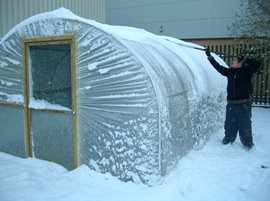January is typically a calmer month in the gardening world but the busy growing months will soon be upon us. Start the year as you mean to go on by drawing up a cropping plan for inside your polytunnel.
While gardens are usually bare due to the lack of daylight and cold temperatures, now is the perfect time to get ahead of the game. So, if you're keen to do some sowing, growing or harvesting at the start of the year, we can help.
Alongside growing fruit, vegetables or flowers, you might consider caring for your polytunnel throughout the month too. Failure to do this may impact future harvests, making it an important task for any gardener.
Our guide below will focus on what plant and flower seeds you can sow in January, general gardening tips for the month and how to look after your polytunnel.
What vegetables and flowers to plant in a polytunnel in January
Aubergines
January is the perfect month to sow your
Aubergines as they can take a while to grow. Sow them in a pot of seed compost and allow them to germinate. Aubergines need warmth and a long growing season, so placing them in a heated propagator within your polytunnel is a good idea. If you start growing your Aubergines in January, they should be ready to harvest as early as July.
Chillies
Sow chilli pepper seeds in pots filled with seed compost and cover with vermiculite. Similarly to aubergines,
chillies need to be placed in propagators to germinate with temperatures above 20°C being optimal. Chillies generally need a long growing season, so the earlier you can sow, the earlier and longer you’ll be able to harvest the fruit.
The hotter chilli varieties tend to take longer to mature, so get them started as soon as you can if you want to enjoy them before the end of summer.
Broad beans
Start growing your
broad beans in January to enjoy a spring harvest. Early crop broad beans can be sown as early as January with the protection of a polytunnel.
If a cold snap is forecast, you can give your tender plants extra protection by covering with
cloches within your polytunnel to act as 'double glazing' and guard your crops from frost damage.
Flowers seeds that can be sown in January
- Sweet peas
- Dahlias
- Geraniums
- Delphinium
- Begonias
- Petunias
- Iceland poppies
- Coleus
What to harvest in January
If you started growing some crops in the previous year, they may be ready to harvest in January. This can include:
- Beetroot
- Lettuce
- Salad leaves
- Kohl rabi
- Celeriac
- Turnip
- Winter cabbage
- Spring onions
- Cauliflower
How to maintain your polytunnel
January is a great month to focus on your polytunnel to ensure it's ready for the upcoming growing season.
Tidying and repairing
Keep on top of tidying and repairing the polytunnel cover.
Algon is the ideal way to clean the polytunnel cover and
repair tape can be used to fix tears or holes, so heat isn't lost during colder months like January.
 Preparing for bad weather
Preparing for bad weather
The British weather can be very wild, making
crop growing in a polytunnel during winter difficult, so be prepared for bad weather. Secure vents and fix door catches tight to protect your polytunnel against strong winds and storms. Doors which rattle in gales can be reinforced using timber braces or placing a heavy weight against the door.
We recommend brushing heavy snowfall off the tunnel as soon as possible as the weight of a big snowfall can put strain on the frame, causing the polythene cover to stretch and sag.
You can remove excess snow by tapping on the sides of the cover and the roof or using a soft brush to knock snow off the harder-to-reach areas. For more stubborn snow use a gas or electric heater inside the polytunnel to turn up the temperature and encourage the snow to slide off.
Prepare and protect your polytunnel when snow and storms are expected by taking a look at our hints and tips in
our growers' blog.
Avoiding pests
If you are using your polytunnel for propagating, ensure pots and trays are not left on the floor. Instead, move them onto staging to give the plants better conditions and prevent slug damage.
Trestle Staging is a simple, practical and portable bench that can be put up and folded away as and when you need it.
Help your garden grow with a Polytunnel this January
Polytunnels let you grow crops through the colder months of the year, making them a wise investment for keen gardeners. Whether you're buying your first or need to replace your existing one, we can help.
Our range of polytunnels comes in different sizes, so you can find a suitable option for your outdoor space.
Want help finding a polytunnel or need advice for growing crops in one in January? Contact us on
01282 811250 or email
info@premierpolytunnels.co.uk to speak to one of our experts today.